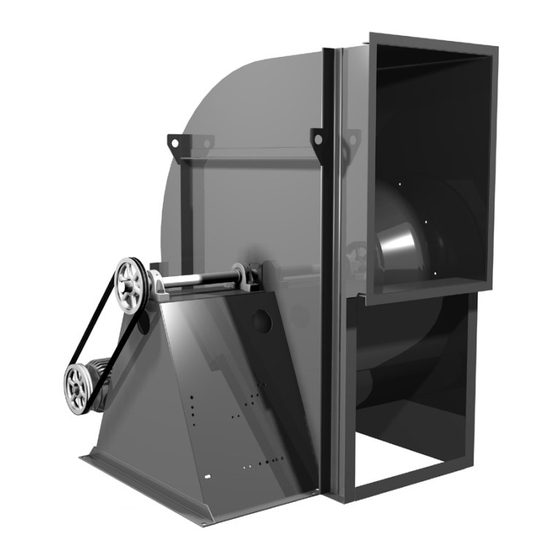COOK CP Series Посібник з монтажу, експлуатації та технічного обслуговування - Сторінка 4
Переглянути онлайн або завантажити pdf Посібник з монтажу, експлуатації та технічного обслуговування для Повітродувка COOK CP Series. COOK CP Series 12 сторінок. Centrifugal blower

CAF-DW
Size
Overlap
INLET
120
1/8"
135–165
5/32"
180
1/4"
195
5/32"
210
1/4"
225
5/32"
245
9/32"
270–445
1/4"
490
17/32"
540–600 27/32"
660–730 25/32"
RADIAL
CLEARANCE
Wiring Installation
Leave enough slack in the wiring to allow for motor move-
ment when adjusting belt tension. Some fractional motors
have to be removed in order to make the connection with
the terminal box at the end of the motor. To remove motor,
remove bolts securing motor base to power assembly. Do
not remove motor mounting bolts.
Units with Arrangement 10 have a hole provided at the
base of the bearing pedestal to accommodate wiring.
NOTICE! Follow the wiring diagram in the discon-
nect switch and the wiring diagram provided with
the motor. Correctly label the circuit on the main
power box and always identify a closed switch to
promote safety (i.e., red tape over a closed switch).
Wheel Rotation
Test the fan to ensure the rotation of the wheel is the
same as indicated by the arrow marked Rotation.
Airfoil
Backward Inclined
115 and 230 Single Phase Motors
Fan wheel rotation is set correctly at the factory. Chang-
ing the rotation of this type of motor should only be at-
tempted by a qualified electrician.
208, 230 and 460 3 Phase Motors
These motors are electrically reversible by switching two
of the supply leads. For this reason, the rotation of the fan
cannot be restricted to one direction at the factory. See
Wiring Diagrams, page 5, for specific information on re-
versing wheel direction.
NOTICE! Do not allow the fan to run in the wrong
direction. This will overheat the motor and cause
serious damage. For 3-phase motors, if the fan is
running in the wrong direction, check the control
switch. It is possible to interchange two leads at
this location so that the fan is operating in the cor-
rect direction.
CA/CF/CP IO&M
WHEEL SHROUD
INLET
RADIAL
CLEARANCE
OVERLAP
OVERLAP
Forward Curved
Belt and Pulley Installation
Belt tension is determined by the sound the belts make when
the fan is first started. Belts will produce a loud squeal which
dissipates after the fan is operating at full capacity. If the belt
tension is too tight or too loose, lost efficiency and possible
damage can occur.
Do not change the pulley pitch diameter to change ten-
sion. This will result in a different fan speed.
1. Loosen motor plate adjustment bolts and move motor in
order that the belts can easily slip into the grooves on the
pulleys. Never pry, roll or force the belts over the rim of
the pulley.
2. Slide the motor plate back until proper tension is reached.
For proper tension, a deflection of approximately 1/4" per
foot of center distance should be obtained by firmly press-
ing the belt. Refer to Figure 1.
3. Lock the motor plate adjustment bolts in place.
4. Ensure pulleys are properly aligned. Refer to Figure 2.
Tolerance
A
Center
Max.
W
Distance
Gap
Up through 12" 1/16"
12" through 48" 1/8"
Over 48"
1/4"
X
Y
Figure 2
Z
Pulley Alignment
Pulley alignment is adjusted by loos-
ening the motor pulley setscrew and by
moving the motor pulley on the motor
shaft.
Figure 2 indicates where to measure
the allowable gap for the drive alignment
tolerance. All contact points (indicated by
WXYZ) are to have a gap less than the
tolerance shown in the table. When the
pulleys are not the same width, the al-
lowable gap must be adjusted by half of the difference in width
(as shown in A & B of Figure 2). Figure 3 illustrates using a car-
penter's square to adjust the position of the motor pulley until
the belt is parallel to the longer leg of the square.
Final Installation Steps
1. Inspect fasteners and setscrews, particularly fan mounting
and bearing fasteners, and tighten according to the table,
Recommended Torque for Setscrews/Bolts.
2. Inspect for correct voltage with voltmeter.
3. Ensure all accessories are installed.
4
Figure 1
OFFSET
ANGULAR
OFFSET/ANGULAR
CENTER
DISTANCE
(CD)
B
GAP
B51181-002
GAP
